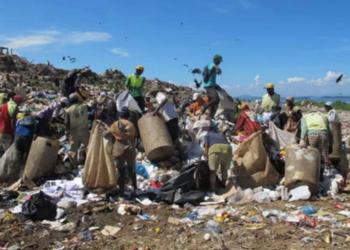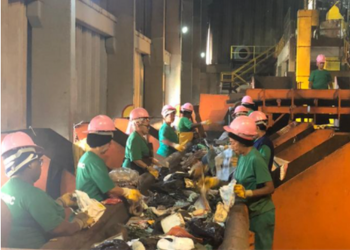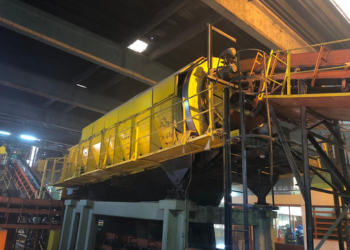Unlike the reality found in the industrialized countries, in Brazil practically there is no segregation at the source, which means household waste is collected mixed. The scenario is almost the same in all Latin American, African, and Eastern European countries.
In these countries, only a very small fraction of household waste has been recycled (no more than 5% of the total) thanks to the effort of informal workers (waste pickers) that have a risky and terrible daily routine, realizing segregation of recyclable materials in the middle of open dumps or in the streets (photos 1 and 2 below) in order to earn minimum resources for the subsistence of their families.


In developing countries such as Brazil, the industrial sector of urban waste treatment plants is still emerging. The household waste is collected mixed (undifferentiated collection) and transported to distant landfills (or open dumpsites), thus generating very high costs (and CO2 emissions) during the collection and transportation services, and also during landfilling, when huge investments are necessary for the infrastructure of collection, drainage and treatment of leachate and methane gas (CH4), high pollutant by-products that are generated when the urban waste is deposited in distant landfills.
Due to this current scenario, in these countries practically everything remains to be done in terms of waste treatment (baseline). So, there is an opportunity to promote the reduction of greenhouse gas (GHG) emissions generated in this important sector of the economy through investments in modern waste treatment plants, promoting significant environmental, social and economic benefits in a short term.
Through the implementation of Mechanical Biological Treatment (MBT) plants, manual workers organized in cooperatives can perform manual sorting activities of recyclable materials on conveyors picking belts (see photo below) in totally safe conditions (covered warehouse, using PPEs, ergonomics, etc.), thus ensuring greater productivity.

It is important to note that the first stages (opening of the waste bags and the first particle size separation) of the treatment process of the mixed waste are done mechanically, using rotary sieves (trommels – see below), without the contact of the workers with the mixed waste.

At the end of the mechanical treatment process, the municipal waste from the undifferentiated (all mixed) collection is subdivided into three large fractions (recyclable, organic and refused material), thus allowing the recovery of each of them with appropriate technology.
Depending on the characteristics of each project, a combination of technologies can be implemented, enabling a reduction of up to 80% (or more) in the volume of waste to be transported to landfills for final disposal.
The scenario is clear: as more materials are recovered and/or renewable energy is generated in waste treatment facilities installed within the urban perimeter, there is a great reduction in the volume of waste at the end of the treatment process that makes it possible to reduce transportation costs, either by reducing the fleet of trucks needed to perform the daily collection and transportation services, either by the shorter transport distances to send the waste that has been collected to the urban waste treatment plant, instead of transporting it to distant landfills. It is also important to consider others social, environmental, and economic benefits related to the costs that will be avoided when reducing landfilling services, including the ones that could be spent for future remediation of the area.
In addition of being more rational in economic terms, by investing in waste treatment plants within the urban perimeter it is also possible to limit Greenhouse Gases (GHG) emissions during all urban waste management, treatment, and final disposal activities, generating Carbon Credits that can be sold in the market.
If the technological option is to also implement an energy recovery plant besides the Mechanical Biological Treatment (MBT) plant, then it is still possible to generate renewable energy through combustion of the refused material fraction (the non-recyclable one, neither organic) to supply energy for homes or to the electric fleet of public vehicles.
Equally important are the others possible positive impacts (social, environmental, and economic) such as: the potential installation of recycling industries to manufacture new products using the selected recyclable waste that are sorted by the cooperatives of waste pickers on the conveyors picking belts, the energy that can be sold with social tariffs, using the sales of carbon credits as a subsidy, and so on.
According to the goals established in the Paris Agreement (COP 21), the agreements signed in the Glasgow Pact (COP 26), the new legal national regulations, and the increased energy costs, there is now a great opportunity for developing countries, such as Brazil, to overcome the historical gap in the urban waste treatment sector.